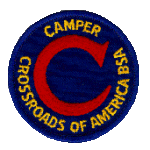Become A Sponsor
|
Why Ads

Firecrafter - Camper Rank

The Camper rank is designed for the first year Camper and is a basic review
of the Tenderfoot requirements. The Camper rank is easily included in a normal
camp schedule; the rank is elementary and earning it should cause little
interference with other camping activities.
The Camper rank must be begun and completed within a five day period. If
the Scout has not completed the requirements in this time he must discard his
requirement card and begin again. This is done to emphasize personal
responsibility. All requirements are geared toward long-term camping, stressing
the importance of including this experience in a Scout's life, a basic
Firecrafter purpose. The Firecrafter program is available to units planning
Lone Troop long-term camping away from an established council camp, upon
application by the Scoutmaster. Applications are available in the Council
Service Center and should be submitted no later than April 15th.
It is important that the instructions be followed carefully so this rank
will be a truly quality review of the Scouting requirements. In each
requirement of Camper, Woodsman, and Firecrafter, the Scout should have passed a
fair, yet rigid examination. To be a truly quality review, the standards of the
Firecrafter camp rank system cannot be lowered. Improper qualification could
harm the camper's chance to complete successfully the higher ranks and lessen
the significance of the rank for others. Camper is easily included in a normal
camp schedule.
Requirements:
The requirements for the Camper rank and some explanations of the
requirements are as follows:
| 1. | Understand and demonstrate the principles and
high
standards of Firecrafter in personal attitude and example, showing respect
for your fellow campers and your environment.
The Scout should perform his given duties in camp and in the campsite.
He should follow the rules of the camp at all times. He shall show respect for
his fellow campers and his environment. If the Scoutmaster wishes to do so, he
may have the Scout stand a brief personal and tent inspection as part of this
requirement. |
| 2. | Repeat from memory the Scout Oath, Law, Motto, and Slogan. Be able to
give the Scout Sign, Salute, and Handshake. Tell the meaning of each in your own
words.
The Scout shall recite from memory the entire wording of the Oath, Law,
Motto, and Slogan. |
| 3. | Tell how Scouting began and how it came to America.
The Scout should tell in his own words how Scouting began and how
Baden-Powell's concepts came to America (see Boy Scout Handbook). |
| 4. | Hiking
| a. | Tell what to do to take a safe hike. |
| b. | Plan and take a hike in the field demonstrating proper methods and courtesies. |
The Scout should explain proper precautions, including road safety,
clothing, hike plan, and common hiking courtesies. The Scout should submit a
hike plan before leaving and report on the experience upon returning to camp.
He should be made aware of of restrictions, boundaries and dangers of camp.
During his hike, he must be accompanied by someone appointed by the leader, the
leader himself, or a qualified staff member. The Scout must demonstrate proper
hiking methods and courtesies throughout the hike. |
| 5. | Compass
| a. | Explain how a compass works. |
| b. | Give the eight (8) principal points and their degree reading. |
| c. | In the field, follow a route through three different degree readings. |
The Scout shall orient a map (preferably a topographical map) and follow
a course outlined on the map, taking at least three degree readings. |
| 6. | Using a topographic map, demonstrate your knowledge of ten (10) common map symbols - including contour lines. |
| 7. | Demonstrate at least one way to find your way by the stars.
This is required so that the Scout may better find his way if he is lost
at night. Preferable methods of determining direction involve locating the
North Star. If observation is prevented by poor weather every night of the
camping trip, this requirement may be satisfied by using cards, charts, or
something similar. |
| 8. | Whip the end of a rope. Tie and explain the uses of the square knot,
bowline, clove hitch, and taut-line hitch. |
| 9. | Demonstrate the proper handling, use, and care of a pocket knife. |
| 10. | Do one hour of service above what is normally expected.
One purpose of this requirement is to let the Scout use his personal
initiative and imagination in deciding which service project he should perform.
Some Scouts may need advice from an encouraging older Scout or the Scoutmaster.
Another purpose of this requirement is to teach the Scout the satisfaction of
doing service above what is normally expected. He may be invited to work for a
longer time to complete the project, but must not be required to do this. |
| 11. | Read the requirements for the rank of
Woodsman.
|
Webmaster Note: This information provided courtesy of Matt Baldwin XXX.
|





